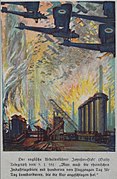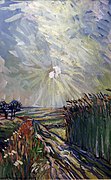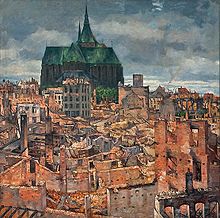Egon Tschirch
This article needs additional citations for verification. (October 2020) |
This article appears to have insufficient references to demonstrate notability. However, an editor has performed a search and claims that there are sufficient sources to indicate that this is a notable topic. (November 2020) |
Egon Tschirch | |
|---|---|
 Self-portrait (1926) | |
| Born | 22 Juny 1889 |
| Died | 5 February 1948 (aged 58) Rostock, Soviet occupation zone |
| Nationality | German |
| Education | Academy of Arts Berlin |

Egon Tschirch (Rostock, 22 June 1889[1]) - 5 February 1948[2]) was a German painter and illustrator. In the 1920s he was regarded as one of the most important artists of Mecklenburg.[3] After the 1930s Tschirch was viewed with skepticism for decades due to his affinity with National Socialism. The rediscovery of a major work in 2015 initiated an ongoing discussion and re-evaluation of the artist and his work.[4]
Early years in the German Empire[]
From 1907 to 1912, Egon Tschirch attended three prestigious Art Academies in Berlin. Among his teachers were Bruno Paul and Anton von Werner.[5] A study trip to Southern France and Tunisia in 1914 awakened his preference for vibrant colours. Tschirch fought in World War I and, after being injured, worked at the Imperial army press office in Berlin producing posters for the department of pictorial propaganda from 1916 to the end of the war.[6] These posters featured darkly colored war targets with corresponding text and messages encouraging wartime perseverance. He returned to Rostock after the war.[3]
Self-portrait (1908)

Bassins des Aglabites, Kairouan (Tunisia) (1914)

What the enemy wants I (1917/18)

What the enemy wants II (1917/18)

Summer day (1919)
Artistic breakthrough in the Weimar Republic[]
His most important creative period lasted from 1919 to the late 1920s. His productivity and willingness to experiment made him the most fitful yet successful artist in Mecklenburg in the early Golden Twenties.[7] Some outstanding examples of the paintings are Boats with Fishermen (1922) at the Rostock Museum of Cultural History and Warnow Fishermen (1923) at Rostock Art Gallery. In 1923, Tschirch created his expressionist cycle of paintings centered around the biblical Song of Songs.[8] These long-forgotten works of art were rediscovered in 2015 after being lost for more than 90 years. Tschirch is also considered a master of portrait art who was able to capture the character and traits of his clients extremely concisely.[9] Several members of Mecklenburg's bourgeoisie were portrayed by him. Examples of this are the portrait Max Samuel (1920) and the series of twenty Heads (1921) that are only labeled with numbers.[3]

Song of Songs, No. 11 (1923)

Song of Songs, No. 19 (1923)

Warnow Fishermen - study (1923)

Max Samuel (1920),(Portrait with suede brush)

Heads (1921), (Portrait Line Ristow)
Stagnation in Nazi era[]
Beginning in the early 1930s, there was little significant artistic development.[10] His art, objective and realistic, fit the times and was mostly appreciated. In the emerging era of Nazism, Egon Tschirch identified for a long time with national conservative views. In 1931 he joined the Nazi Party.[11] Several works on commission in the service of the Nazi regime and persistently plentiful assignments from private individuals enabled him to live a comfortable life until the beginning of the Second World War. Only when the systematic extermination of the Jews began and his hometown was destroyed in 1942 did Tschirch criticise National Socialism and become inwardly distant.[12] He finally turned away from the regime. In St. Mary's Church in Rostock there still hangs a famous painting from this time depicting the church surrounded by the city’s ruins.[3]
In 1948, Egon Tschirch died childless in Rostock at the age of 58.[3]

Reception[]
In the summer of 1937 there were discussions about whether some of his works from the early 1920s should be classified as Degenerate art and removed from the State Museum Schwerin. The intervention of advocates on his behalf prevented this.[13]
Tschirch was treated with caution and largely forgotten in East Germany.[14]
The rediscoveries of the Song of Songs cycle and the Portrait Max Samuel in 2015 set in motion a new contemporary debate.[4] The first monograph on his life and work was published in 2020.[3] From today's perspective, the contradictions between Tschirch's work and mentality are evident. His art, which by far surpasses its artist in character, remains of enormous importance for Mecklenburg and beyond.[3]
References[]
- ^ Archiv der Hansestadt Rostock: Geburtsregister. 1889 Nr. 608
- ^ Archiv der Hansestadt Rostock: Sterberegister. 1948 Nr. 215
- ^ Jump up to: a b c d e f g Egon Tschirch: Leben und Werk (Monograph), Kulturhistorische Gesellschaft Rostock e.V. (ed.), Rostock: Hinstorff Verlag GmbH, 2020, ISBN 978-3-356-02309-1
- ^ Jump up to: a b Egon Tschirch in Art Museum Ahrenshoop. http://kunstmuseum-ahrenshoop.de/veranstaltungen.html Website Kunstmuseum Ahrenshoop. Retrieved November 18, 2020.
- ^ Archive of the Academy of Arts, Berlin: Curriculum vitae by Egon Tschirch. May 18, 1910. In: Königliche Kunstschule – Alphabetisches Verzeichnis Schuljahr 1909/10
- ^ Werner Tschirch: Egon Tschirch, sein Leben. Eigenverlag, Berlin, 1974, p. 12-14
- ^ Wolf Karge: "Künstlervereinigungen 1900-1933" in „Bildende Kunst in Mecklenburg 1900-1945“ Hinstorff Verlag, Rostock 2010, p. 83-84, ISBN 978-3-356-01406-8
- ^ Artmapp Frühjahr 2017: Das Hohelied in Farben, March 17, 2017, p. 44–47
- ^ Mecklenburger Warte, April 10, 1921
- ^ Marcus Pfab: Rostocker Kunst der 1920er bis 40er Jahre – Zwischen Traditionalismus und gemäßigter Moderne. Staatsexamensarbeit Universität Greifswald – Diplomarbeiten-Agentur, 1998, ID 929, p. 39
- ^ Archiv der Hansestadt Rostock, January 15, 1948, 1.2.0-1388 p. 285: Personalfragebogen
- ^ Werner Tschirch: Egon Tschirch, sein Leben. Eigenverlag, Berlin, 1974, p. 42
- ^ Landeshauptarchiv Schwerin: General-Akten betr. das Meckl. Landesmuseum 1929-1938, August 13/21/23 & September 8, 1937, 5.12-7/1 Nr. 6748
- ^ Ingrid Möller: Das mecklenburgische Reutergeld von 1921. Pekrul & Sohn GbR, Edition digital 2015, p. 379, ISBN 978-3-95655-583-1
External links[]
- German male painters
- 20th-century German painters
- 20th-century male artists
- German Expressionism
- Expressionism
- 1889 births
- 1948 deaths
- People from Rostock
- Artists from Mecklenburg-Vorpommern









